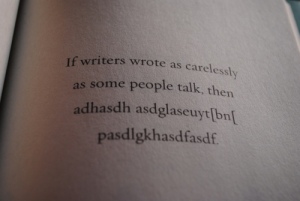Every writer has the responsibility to make sure that their work is free from errors. This is true whether you are writing content for your own website or writing articles for a client.

Nothing is worse than an article with typographical errors and misspelled words. And if the grammar is wrong, the piece itself loses its value no matter how interesting the topic is. Even though you are an expert on the subject you're writing about, poor grammar can drive away most of your readers.
So how can you make sure that your writing is ready for the world? Consider these tips when proofreading your own work:
Take a break. Don't try to edit your work right after you've finished writing the piece. Go for a walk. Take a nap. Do your chores. After a break, you will be able to see your writing more clearly and with a new perspective.
Read the whole article first. Highlight the words or sentences that need changes and go back after reading the entire article. Experienced writers recommend reading from a printed page rather than from a computer screen. I think this advice is most apt for book writers.
If you are an SEO writer, printing out articles before reading them can be time-consuming and a waste of precious paper. What you can do is read the piece from beginning to end, marking the errors using the MS Word highlight tool. Apply the necessary changes. When you're done, read the entire article once again.
 Read aloud. It would be easier to spot wrong grammar, awkward phrases and redundancies when you can hear the sentences.
Read aloud. It would be easier to spot wrong grammar, awkward phrases and redundancies when you can hear the sentences.
However, make sure that you are not just reading from memory. People have a tendency to overlook errors because they are reciting from memory. Let your eyes be your guide. Read every word from the page and focus on what your eyes see.
Set a schedule exclusively for editing. Editing a written piece does take time. You are bound to miss important details that need revision if you are rushing.
Compress. Some sentences or words may be unnecessary and can be omitted without changing the meaning or taking away from the quality of the article. Also, some readers get discouraged when they see a very lengthy piece. So unless that phrase or sentence is truly relevant, delete it.
Review. Try re-editing after a few hours or the next day or after a week if your time allows. You may have spotted a few errors before but you might be surprised to find other needed corrections later.
Would you like to share your personal tips on editing? Are these tips helpful?  I'd LOVE to know what you think so if you feel like commenting, please do:)
I'd LOVE to know what you think so if you feel like commenting, please do:)
 I'd LOVE to know what you think so if you feel like commenting, please do:)
I'd LOVE to know what you think so if you feel like commenting, please do:)"A sentence should contain no unnecessary words, a paragraph no unnecessary sentences, for the same reason that a drawing should have no unnecessary lines and a machine no unnecessary parts." - William Strunk
What did you think of this article? I’d love to hear your thoughts. If you enjoyed the read or if you find it useful, kindly please click any of the sharing icons below. You can Tweet, Stumble, Share it on Facebook or +1 it.
Thanks a lot,
Rachel:)
Photo sources:
1. take a walk before editing
2. read each word aloud
3. writer on a typewriter
*This article was originally published on rachewrites.blogspot.com on April 21, 2009.
No comments:
Post a Comment